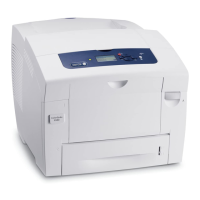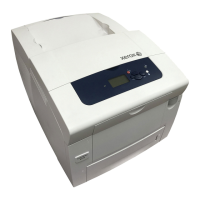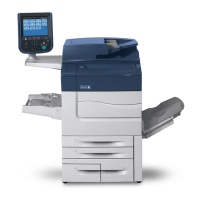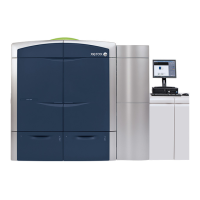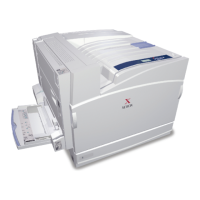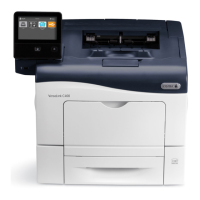October 2012
6-45
ColorQube 8570/8870 Service Manual
Noise Troubleshooting
General Troubleshooting
Xerox Internal Use Only - Revised, 3rd Revision
Noise Troubleshooting
Various noises could occur while the printer is in operation at different stage (refer to Printing
Process (Stages)) which consist of different clicking, beeping, and whirring noises. These
should be considered normal operation if they happen only during power up and not during
printing.
Noises during printing should be slight and should include a whirring noise as well as paper
movement noises. A metallic clicking sound can be heard when the printer prints the second
side of a two-sided print.
Printing Process (Stages)
• Drum Preparation - A thin coating of silicone oil is applied to the surface of the Drum.
• Printing - The Drum starts rotating at a speed dependent upon print resolution. As the
Drum reaches the correct speed, the jets begin to fire to deposit the image on the oiled
portion of the Drum. As the jets fire, the Printhead moves from right to left to complete the
image on the Drum.
• Transfix and Exiting -
– Stages the paper for rendezvous with the image on the Drum and Transfix Roller nip.
– Loads the Transfix Roller and engages the Stripper Blade.
– Strips the paper from the Drum.
– Exits the paper from the printer, or exits the paper for 2-sided printing.
Sound Reduction Mode
When enabled, lowers Fast Color, Standard, and Enhanced PostScript print mode speeds to
reduce overall sound levels. Table 1 contains the print speed changed for simplex and duplex
printing when Sound Reduction is activated.
Normal Noises
These noises are considered normal but may sound strange to those unfamiliar with a Solid
Ink printer.
Abnormal Noises Due to Failures (No Service Faults)
The following noises can occur during printing or non-printing operations. Though they do not
result in an obvious loss of functionality or a service fault, they are hardware failures and
should be considered abnormal.
Table 1 Print Speed
Pages per Minute Fast Color Standard Enhanced Photo
Default 40/30 30/25 19/18 6/4
Sound Reduction 25/22 22/20 16/15 6/4
Table 2 Normal Noises
Defect Description Noise Sample
NOTE: Click on each noise sample link under the Noise Sample column to hear the sound
sample.
Printing
NOTE: Four pages are printed for simplex and duplex sound samples.
Simplex, A-size, 20lb,
Tray 2, Enhanced Mode
The printer makes whirling and paper move-
ment noises while is printing A-size paper
Simplex in Enhanced mode.
A-Size Simplex,
Enhanced
Duplex, A-size, 20lb,
Tray 2, Enhanced Mode
The printer makes whirling and paper move-
ment noises while is printing A-size paper
Duplex in Enhanced mode.
A-Size Duplex,
Enhanced
Simplex, A-size, 20lb,
Tray 2, Fast Mode
The printer makes whirling and paper move-
ment noises while is printing A-size paper
Simplex in Fast mode.
A-Size Simplex, Fast
Duplex, A-size, 20lb,
Tray 2, Fast Mode
The printer makes whirling and paper move-
ment noises while is printing A-size paper
Duplex in Fast mode.
A-Size Duplex, Fast
Non-Printing
Ink Loading The Ink Loader makes clicking sound while
loading ink sticks.
Ink Loading
Enter Power Saver
Mode
If the printer sits idle for two hours, it goes
into an Energy-saving Standby mode. Two
hours after that, the printer goes into a
Power Saver (ENERGY STAR) mode. When
the printer does this, it tilts the Printhead
back into a parked position. This accounts
for some of the noises the printer makes
after it has been idle for four hours. (The
ENERGY STAR time delay may be as long
as 4 hours or as short as 30 minutes,
depending on what Power Saver Timeout
has been set to.)
Enter Power Saver
Exit Power Saver Mode The printer makes various noises when exit-
ing Power Saver mode.
Exit Power Saver
Table 3 Abnormal Noises Due to Failures
Defect Description Procedure Noise Sample
NOTE: Click on each noise sample link under the Noise Sample column to hear the sound
sample.
Printing
Drum Ground
Plane Rubbing
The Drum ground plane on the left side
of the Exit Module is held in place by a
post feature of the Exit Module. If the
post breaks, the ground plane can
come into contact with the Drum Pulley
resulting a metallic rubbing noise.
OF1 Drum Ground
Plane Rubbing
Table 2 Normal Noises
Defect Description Noise Sample
NOTE: Click on each noise sample link under the Noise Sample column to hear the sound
sample.

